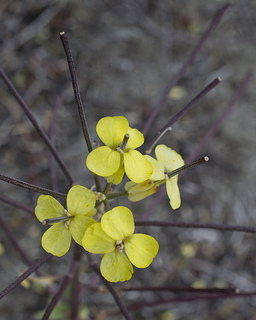(Erysimum menziesii)
 Erysimum menziesii. CDFW Photo by Jeb Bjerke.
Erysimum menziesii. CDFW Photo by Jeb Bjerke.
 Erysimum menziesii. CDFW illustration by Mary Ann Showers. (Click to enlarge)
Erysimum menziesii. CDFW illustration by Mary Ann Showers. (Click to enlarge)
Menzies’ wallflower is a California endangered plant species, which means that killing or possession of plants collected from the wild is prohibited by the California Endangered Species Act (CESA). Three subspecies of Menzies’ wallflower are each separately listed as endangered under the federal Endangered Species Act, however these subspecies names are not considered to be validly published. Menzies’ wallflower is found in Northern and Central California at four disjunct dune systems along the Pacific Ocean. These four locations are Humboldt Bay in Humboldt County, Ten Mile River in Mendocino County, the Marina Dunes at Monterey Bay, and the Monterey Peninsula in Monterey County. At the time of this webpage posting, the California Natural Diversity Database reports 19 occurrences of Menzies’ wallflower, three of which are possibly extirpated. Menzies’ wallflower is a perennial plant, but it flowers and produces fruit only once during its lifetime and then dies. Menzies’ wallflower typically blooms from March through April.
Threats to Menzies’ wallflower include displacement by invasive plant species; trampling from hikers and equestrians; sand mining; commercial and residential development; off-road vehicle use; erosion and impacts from deer grazing. Because some occurrences are now protectively managed or on land owned by state or federal agencies, they are afforded some protection from development, mining and off-road vehicle use. However, Menzies’ wallflower remains vulnerable, particularly on unprotected land.
To protect Menzies’ wallflower from extinction, occupied habitat should be protected by purchasing land, establishing conservation easements, or by other legal mechanisms; permanent and ongoing invasive species control and prevention should be funded and institutionalized at Menzies’ wallflower populations; populations of Menzies’ wallflower should be monitored and population estimates should be conducted; genetic and morphological investigations into Menzies wallflower taxonomy should be conducted; reintroduction and restoration opportunities should be pursued; and impacts from deer and erosion should be reduced.
CDFW has implemented the following restoration projects for Menzies’ wallflower with California Endangered Species Tax Check-off Funds and through participation in the federal Cooperative Endangered Species Conservation Fund:
CDFW may issue permits for Menzies’ wallflower pursuant to CESA, and you can learn more about the California laws protecting Menzies’ wallflower and other California native plants. Populations of Menzies’ wallflower occur in CDFW’s Northern Region and Central Region. More information is also available from the U.S. Fish and Wildlife Service Species Profile for Menzies’ wallflower.
Updated 06/18/2013